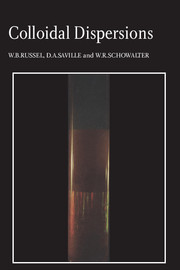Book contents
- Frontmatter
- ACKNOWLEDGEMENTS
- Contents
- Preface
- Units and physical constants
- Mathematical symbols
- 1 A Survey of Colloidal Dispersions
- 2 Hydrodynamics
- 3 Brownian Motion
- 4 Electrostatics
- 5 Dispersion forces
- 6 Forces due to soluble polymer
- 7 Electrokinetic phenomena
- 8 Electrostatic stabilization
- 9 Polymeric stabilization
- 10 Equilibrium phase behavior
- 11 Particle capture
- 12 Sedimentation
- 13 Diffusion
- 14 Rheology
- Appendix A Measured properties
- Appendix B Vector and tensor notation
- Author index
- Subject index
12 - Sedimentation
Published online by Cambridge University Press: 05 August 2012
- Frontmatter
- ACKNOWLEDGEMENTS
- Contents
- Preface
- Units and physical constants
- Mathematical symbols
- 1 A Survey of Colloidal Dispersions
- 2 Hydrodynamics
- 3 Brownian Motion
- 4 Electrostatics
- 5 Dispersion forces
- 6 Forces due to soluble polymer
- 7 Electrokinetic phenomena
- 8 Electrostatic stabilization
- 9 Polymeric stabilization
- 10 Equilibrium phase behavior
- 11 Particle capture
- 12 Sedimentation
- 13 Diffusion
- 14 Rheology
- Appendix A Measured properties
- Appendix B Vector and tensor notation
- Author index
- Subject index
Summary
Introduction
The sedimentation of colloidal particles is important both in technology and in the laboratory. Gravity settlers, thickeners, or clarifiers commonly remove particles from waste streams issuing from a variety of processes. These generally operate as continuous processes that split the feed into two product streams, one the clear fluid and the other a sludge. Successful design requires knowledge of the sedimentation velocity of the particles over the relevant range of volume fractions and the role of interparticle forces in determining the structure of the dense sludge. Centrifugation provides a means of enhancing the driving force for commercial-scale operations, as well as concentrating or analyzing dispersions in the laboratory.
Despite their longstanding use, much remains to be understood about the details of processes which convert dilute dispersions into dense sediments. The key issues appear to be
(i) the variation of the settling velocity with volume fraction and interparticle potential,
(ii) the role of forces transmitted by interparticle potentials, and
(iii) the formulation of macroscopic models to predict the evolution of volume fraction as a function of position and time.
As with other colloidal phenomena, the complexity arises from the importance of a variety of interparticle forces and the fact that many systems of interest tend to be flocculated.
- Type
- Chapter
- Information
- Colloidal Dispersions , pp. 394 - 428Publisher: Cambridge University PressPrint publication year: 1989
- 3
- Cited by

